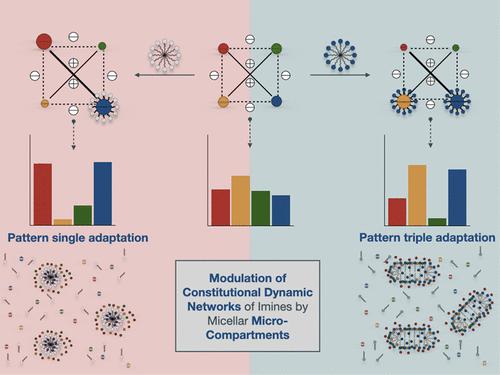当前位置:
X-MOL 学术
›
J. Am. Chem. Soc.
›
论文详情
Our official English website, www.x-mol.net, welcomes your feedback! (Note: you will need to create a separate account there.)
Triple Adaptation of Constitutional Dynamic Networks of Imines in Response to Micellar Agents: Internal Uptake–Interfacial Localization–Shape Transition
Journal of the American Chemical Society ( IF 15.0 ) Pub Date : 2024-03-25 , DOI: 10.1021/jacs.3c14200 Tanguy Rieu 1 , Artem Osypenko 1 , Jean-Marie Lehn 1
Journal of the American Chemical Society ( IF 15.0 ) Pub Date : 2024-03-25 , DOI: 10.1021/jacs.3c14200 Tanguy Rieu 1 , Artem Osypenko 1 , Jean-Marie Lehn 1
Affiliation

|
Understanding the behavior of complex chemical reaction networks and how environmental conditions can modulate their organization as well as the associated outcomes may take advantage of the design of related artificial systems. Microenvironments with defined boundaries are of particular interest for their unique properties and prebiotic significance. Dynamic covalent libraries (DCvLs) and their underlying constitutional dynamic networks (CDNs) have been shown to be appropriate for studying adaptation to several processes, including compartmentalization. However, microcompartments (e.g., micelles) provide specific environments for the selective protection from interfering reactions such as hydrolysis and an enhanced chemical promiscuity due to the interface, governing different processes of network modulation. Different interactions between the micelles and the library constituents lead to dynamic sensing, resulting in different expressions of the network through pattern generation. The constituents integrated into the micelles are protected from hydrolysis and hence preferentially expressed in the network composition at the cost of constitutionally linked members. In the present work, micellar integration was observed for two processes: internal uptake based on hydrophobic forces and interfacial localization relying on attractive electrostatic interactions. The latter drives a complex triple adaptation of the network with feedback on the shape of the self-assembled entity. Our results demonstrate how microcompartments can enforce the expression of constituents of CDNs by reducing the hydrolysis of uptaken members, unravelling processes that govern the response of reactions networks. Such studies open the way toward using DCvLs and CDNs to understand the emergence of complexity within reaction networks by their interactions with microenvironments.
中文翻译:

亚胺组成动态网络响应胶束剂的三重适应:内部吸收-界面定位-形状转变
了解复杂化学反应网络的行为以及环境条件如何调节其组织以及相关结果可以利用相关人工系统的设计。具有明确边界的微环境因其独特的性质和益生元的意义而受到特别关注。动态共价库 (DCvL) 及其底层动态网络 (CDN) 已被证明适合研究对多种过程的适应,包括区室化。然而,微区室(例如胶束)提供了特定的环境,用于选择性保护免受干扰反应,例如水解和由于界面而增强的化学混杂性,控制网络调节的不同过程。胶束和库成分之间的不同相互作用导致动态传感,从而通过模式生成产生不同的网络表达。整合到胶束中的成分受到保护免于水解,因此优先在网络组合物中表达,但以结构上连接的成员为代价。在目前的工作中,观察到胶束整合的两个过程:基于疏水力的内部吸收和依赖于吸引的静电相互作用的界面定位。后者通过对自组装实体形状的反馈来驱动网络的复杂三重适应。我们的结果证明了微区室如何通过减少吸收成员的水解来增强 CDN 成分的表达,从而揭示控制反应网络响应的过程。此类研究为使用 DCvL 和 CDN 来了解反应网络通过与微环境的相互作用而出现的复杂性开辟了道路。
更新日期:2024-03-25
中文翻译:

亚胺组成动态网络响应胶束剂的三重适应:内部吸收-界面定位-形状转变
了解复杂化学反应网络的行为以及环境条件如何调节其组织以及相关结果可以利用相关人工系统的设计。具有明确边界的微环境因其独特的性质和益生元的意义而受到特别关注。动态共价库 (DCvL) 及其底层动态网络 (CDN) 已被证明适合研究对多种过程的适应,包括区室化。然而,微区室(例如胶束)提供了特定的环境,用于选择性保护免受干扰反应,例如水解和由于界面而增强的化学混杂性,控制网络调节的不同过程。胶束和库成分之间的不同相互作用导致动态传感,从而通过模式生成产生不同的网络表达。整合到胶束中的成分受到保护免于水解,因此优先在网络组合物中表达,但以结构上连接的成员为代价。在目前的工作中,观察到胶束整合的两个过程:基于疏水力的内部吸收和依赖于吸引的静电相互作用的界面定位。后者通过对自组装实体形状的反馈来驱动网络的复杂三重适应。我们的结果证明了微区室如何通过减少吸收成员的水解来增强 CDN 成分的表达,从而揭示控制反应网络响应的过程。此类研究为使用 DCvL 和 CDN 来了解反应网络通过与微环境的相互作用而出现的复杂性开辟了道路。



























 京公网安备 11010802027423号
京公网安备 11010802027423号